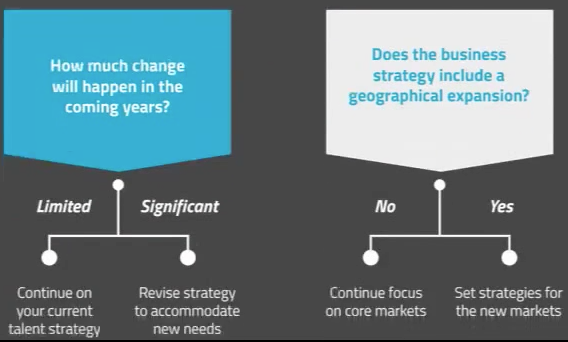Module 1
#1.1
The financial reason
Great companies attract great talent
Talent choose to come and choose to stay with the companies where they feel their pay and opportunities are better than elsewhere. But for the best companies, there is also and X factor - a strong company culture.
A strongly shared sense of culture and purpose can drive extraordinary levels of motivation, loyalty and performance. A crystal-clear focus of a handful key qualities - like creativity or simplicity or agility - can likewise provide your organisation with capabilities that others find difficult to match.
This powerful combination of differentiation capabilities and distinctive cultural identity helps to attract the 'right' kind of talent, which in turn helps deliver unique products and services.
However, there is a problem...
According to surveys, many top managers find the talent issue both business critical and very urgent. So, what must HR do? Well, first of all we must rethink HR's role. HR need to become more strategic, more agile, take on new competencies and get rid of others. Many traditional HR tasks, such as handling payrolls, have become automated. Instead HR need more people skilled in analytics and IT in order to fulfil the business needs of the organisation.
CEO's are increasingly becoming worried about finding talent with the right skills.
Source: PwC's The talent challenge: Adapting to growth
More info in Dig deeper
9 out of 10
executives say they have "pressing needs" for digital talent, such as developers, analysts and UX designers.
Source: McKinsey Global study: The Digital Tipping Point
43%
of CEO's, CFO's and HR Directors believed that poor human capital management had kept them from reaching their key financial targets in the previous 18 months.
Source: Talent Pipeline Draining Growth: Connecting Human Capital to the Growth Agenda, a CGMA, Sept 2012
39%
of CFO's and other C-suite executives say that they are "barely able" or "unable" to find the talent they need to execute against their business goals.
Source: 2013 Deloitte Talent Survey
Luckily there is a solution
LinkedIn and BCG have been able to show how a strong employer brand can create clear financial benefits. You can read the whole reports and the end of this module, but for now, try to guess by how much.
Think for a moment, then hover over the examples to reveal the figures
A strong employer brand leads to:
[ LinkedIn ]
* LinkedIn White paper, Why you employer brand matters, 2012, based on 7,250 LinkedIn members worldwide
Companies most successful at improving their employer brand outperform other companies by factors:
[ BCG ]
"But wait, won't a strong corporate
or consumer brand do the job?"
Sorry - although a strong corporate and consumer brand drives awareness of your company it rarely is enough to attract the right people to work for you. A strong employer brand is twice as likely to bring actual job considerations. In fact, if your company brand image differs too much from the daily work experiences of your employees it may lead to internal dissatisfaction.
You'll learn more about aligning the two later...
#1.2
Involve critical stakeholders
Start by involving the right people
If your top management understands the importance of a thorough employer brand work, you probably already have their attention, and a reasonable budget. If not, make sure you get direct contact with the right people in your organisation.
One way of doing it is to create an employer brand council, as Ann Ericsson, Group Employer Brand Manager at Skanska, did. Hear her story here.
[X] You'll get a template
Find the arguments they want to hear
These organisation roles should be included in your employer brand work.
Ask yourself: are they aboard? If not, how should you approach them to get their attention?
[X] Click anywhere in the image to read more!
#1.4
The nine steps
One step at a time
Remember these? These are the nine steps of creating a successful employer brand. In this module we will work through the first three...
Hoover over the boxes to learn more!
#1.4
Understand the business plan
Align with the business goals
One of the most fundamental parts when setting the employer strategy is to understand the organisation's long-term talent needs. By understanding the long-term business objectives, you can identity the critical talent needs, that is the talent that will have the greatest impact on the company's ability to reach long-term business objectives.
There are two key questions to ask when reviewing the business strategy:
Here is a typical business plan in short. This company aims for significant change and geographical expansion.
BUSINESS STRATEGY
- Revenue growth + 30%
- Profitability +10%
- Geographical expansion
- Introduction of new services
- From product focus to solution focus
Talent strategy
- Buy or build?
The most important thing to consider and decide upon in the Talent strategy is whether to develop and promote young talent from within the company, or favoured experienced hires.
WORKFORCE PLAN
- 1,200 new engineers
- 300 sales executives
- 150 product developers
- ...in Russia, China and Indonesia
This company's business strategy is most certainly dependant on finding the right talent, in the right places.
A geographical shift is needed, of course. But also a shift towards attracting younger people, for example by focusing on innovation and CSR.
Employer branding strategy
- Increased attractiveness in key markets
- Increased focus towards young professionals
- Repositioning towards innovation, fast-growing and CSR
- Increased retention in mature markets
#1.5
Map your talent need
Translate the business plan into talent need
This template helps you first identify the critical talent needs, and then conduct a talent inventory based on the needs. The purpose of the inventory is to find out whether the critical talent already exists in the organisation or if it needs to be recruited. At the end of this module you can download a template.
Now - take a look at these examples before you proceed.




